04-20-2022-0837 - 6083/4-5,6-7
Blog Archive
- Apr 12 (12)
- Apr 13 (2)
- Apr 14 (7)
- Apr 15 (11)
- Apr 16 (5)
- Apr 17 (14)
- Apr 18 (16)
- Apr 19 (17)
- Apr 20 (28)
- Apr 21 (29)
- Apr 22 (15)
- Apr 23 (19)
- Apr 24 (8)
- Apr 25 (58)
- Apr 26 (44)
- Apr 28 (6)
- Apr 29 (6)
- Apr 30 (7)
- May 01 (8)
- May 02 (9)
- May 03 (4)
- May 04 (6)
- May 05 (14)
- May 06 (20)
- May 07 (11)
- May 08 (18)
- May 09 (6)
- May 10 (17)
- May 11 (8)
- May 12 (25)
- May 13 (8)
- May 14 (2)
- May 15 (2)
- May 17 (16)
- May 18 (1)
- May 19 (5)
- May 20 (22)
- May 21 (6)
- May 22 (3)
- May 23 (2)
- May 24 (7)
- May 25 (1)
- May 26 (6)
- May 27 (3)
- May 28 (3)
- May 29 (10)
- May 30 (8)
- May 31 (12)
- Jun 01 (1)
- Jun 02 (1)
- Jun 03 (9)
- Jun 04 (1)
- Jun 05 (2)
- Jun 07 (4)
- Jun 08 (8)
- Jun 09 (1)
- Jun 10 (1)
- Jun 19 (1)
- Jun 27 (1)
- Jun 29 (1)
- Jun 30 (7)
- Jul 01 (3)
- Jul 02 (1)
- Jul 03 (1)
- Jul 04 (2)
- Jul 05 (1)
- Jul 06 (3)
- Jul 08 (9)
- Jul 09 (1)
- Jul 10 (1)
- Jul 11 (2)
- Jul 12 (2)
- Jul 13 (4)
- Jul 14 (4)
- Jul 15 (2)
- Jul 17 (8)
- Jul 18 (17)
- Jul 19 (1)
- Jul 20 (8)
- Jul 21 (6)
- Jul 22 (12)
- Jul 23 (10)
- Jul 25 (6)
- Jul 26 (23)
- Jul 28 (50)
- Jul 30 (12)
- Jul 31 (5)
- Aug 01 (16)
- Aug 02 (5)
- Aug 03 (5)
- Aug 04 (11)
- Aug 05 (13)
- Aug 06 (7)
- Aug 07 (10)
- Aug 08 (2)
- Aug 09 (27)
- Aug 10 (15)
- Aug 11 (67)
- Aug 12 (44)
- Aug 13 (29)
- Aug 14 (120)
- Aug 15 (61)
- Aug 16 (36)
- Aug 17 (21)
- Aug 18 (5)
- Aug 21 (5)
- Aug 22 (54)
- Aug 23 (101)
- Aug 24 (100)
- Aug 25 (99)
- Aug 26 (100)
- Aug 27 (84)
- Aug 28 (73)
- Aug 29 (76)
- Aug 30 (67)
- Aug 31 (95)
- Sep 01 (126)
- Sep 02 (68)
- Sep 03 (11)
- Sep 04 (14)
- Sep 05 (47)
- Sep 06 (101)
- Sep 07 (61)
- Sep 08 (57)
- Sep 09 (46)
- Sep 10 (14)
- Sep 11 (93)
- Sep 12 (101)
- Sep 13 (101)
- Sep 14 (100)
- Sep 15 (77)
- Sep 16 (2)
- Sep 17 (101)
- Sep 18 (91)
- Sep 19 (102)
- Sep 20 (102)
- Sep 21 (94)
- Sep 22 (84)
- Sep 23 (110)
- Sep 24 (101)
- Sep 25 (76)
- Sep 26 (43)
- Sep 27 (87)
- Sep 28 (104)
- Sep 29 (92)
- Sep 30 (33)
- Oct 01 (58)
- Oct 02 (1)
- Oct 05 (8)
- Oct 06 (6)
- Oct 07 (4)
- Oct 08 (4)
- Oct 09 (1)
- Oct 10 (18)
- Oct 11 (8)
- Oct 12 (26)
- Oct 13 (6)
- Oct 14 (2)
- Oct 15 (4)
- Oct 16 (3)
- Oct 17 (4)
- Oct 18 (3)
- Oct 19 (11)
- Oct 20 (5)
- Oct 21 (7)
- Oct 22 (5)
- Oct 23 (8)
- Oct 24 (9)
- Oct 25 (14)
- Oct 26 (8)
- Oct 27 (13)
- Oct 28 (7)
- Oct 29 (7)
- Oct 30 (22)
- Oct 31 (13)
- Nov 01 (13)
- Nov 02 (6)
- Nov 03 (10)
- Nov 04 (17)
- Nov 05 (8)
- Nov 06 (9)
- Nov 07 (11)
- Nov 08 (3)
- Nov 09 (7)
- Nov 10 (5)
- Nov 11 (5)
- Nov 12 (5)
- Nov 13 (10)
- Nov 14 (7)
- Nov 15 (15)
- Nov 16 (8)
- Nov 17 (6)
- Nov 18 (5)
- Nov 19 (7)
- Nov 20 (8)
- Nov 21 (12)
- Nov 22 (5)
- Nov 23 (7)
- Nov 24 (7)
- Nov 25 (8)
- Nov 26 (2)
- Nov 27 (12)
- Nov 28 (2)
- Nov 29 (2)
- Dec 01 (1)
- Dec 02 (3)
- Dec 03 (2)
- Dec 04 (1)
- Dec 05 (9)
- Dec 06 (22)
- Dec 07 (2)
- Dec 08 (3)
- Dec 09 (1)
- Dec 13 (2)
- Dec 14 (12)
- Dec 15 (1)
- Dec 17 (1)
- Dec 23 (4)
- Dec 24 (2)
- Dec 25 (1)
- Dec 27 (2)
- Dec 28 (1)
- Dec 29 (6)
- Dec 30 (2)
- Dec 31 (6)
- Jan 03 (3)
- Jan 04 (12)
- Jan 05 (5)
- Jan 06 (7)
- Jan 07 (1)
- Jan 08 (3)
- Jan 09 (1)
- Jan 11 (1)
- Jan 12 (5)
- Jan 14 (1)
- Jan 16 (1)
- Jan 17 (1)
- Jan 18 (2)
- Jan 23 (1)
- Jan 26 (3)
- Jan 28 (2)
- Jan 29 (3)
- Jan 30 (1)
- Jan 31 (1)
- Feb 04 (2)
- Feb 05 (2)
- Feb 08 (2)
- Feb 09 (1)
- Feb 13 (3)
- Feb 15 (2)
- Feb 16 (1)
- Feb 17 (1)
- Feb 25 (2)
- Feb 28 (2)
- Mar 03 (1)
- Mar 08 (3)
- Mar 16 (2)
- Mar 17 (1)
- Mar 18 (11)
- Mar 20 (9)
- Mar 22 (1)
- Mar 23 (3)
- Mar 31 (1)
- Apr 01 (2)
- Apr 02 (1)
- Apr 03 (2)
- Apr 04 (1)
- Apr 05 (2)
- Apr 06 (6)
- Apr 07 (1)
- Apr 08 (7)
- Apr 09 (4)
- Apr 10 (7)
- Apr 19 (18)
- Apr 20 (12)
- Apr 21 (1)
- Apr 24 (2)
- May 11 (1)
- May 16 (4)
- May 20 (2)
- May 24 (2)
- May 27 (3)
- Jun 02 (2)
- Jun 06 (1)
- Jun 07 (9)
- Jun 10 (1)
- Jun 11 (2)
- Jun 12 (3)
- Jun 15 (1)
- Jun 17 (1)
- Jun 20 (5)
- Jun 21 (12)
- Jun 22 (21)
- Jun 23 (10)
- Jun 24 (4)
- Jun 25 (10)
- Jun 26 (5)
- Jun 28 (4)
- Jun 29 (2)
- Jun 30 (2)
- Jul 01 (1)
- Jul 04 (1)
- Jul 05 (2)
- Jul 06 (1)
- Jul 07 (2)
- Jul 08 (1)
- Jul 09 (3)
- Jul 10 (6)
- Jul 11 (7)
- Jul 12 (2)
- Jul 13 (3)
- Jul 14 (7)
- Jul 15 (4)
- Jul 16 (9)
- Jul 17 (2)
- Jul 18 (6)
- Jul 19 (6)
- Jul 20 (14)
- Jul 21 (2)
- Jul 22 (6)
- Jul 23 (14)
- Jul 24 (6)
- Jul 25 (5)
- Jul 26 (5)
- Jul 27 (2)
- Jul 28 (6)
- Jul 29 (1)
- Jul 30 (3)
- Jul 31 (1)
- Aug 01 (6)
- Aug 03 (6)
- Aug 04 (4)
- Aug 05 (2)
- Aug 06 (2)
- Aug 07 (1)
- Aug 08 (1)
- Aug 09 (1)
- Aug 10 (1)
- Aug 11 (3)
- Aug 12 (1)
- Aug 13 (1)
- Aug 14 (1)
- Aug 15 (1)
- Aug 17 (9)
- Aug 19 (1)
- Aug 24 (1)
- Aug 28 (1)
- Oct 14 (1)
- Oct 22 (1)
- Nov 13 (10)
- Nov 14 (1)
- Nov 15 (3)
- Nov 23 (2)
- Nov 24 (1)
- Nov 25 (1)
- Nov 26 (1)
- Dec 01 (3)
- Dec 07 (3)
- Dec 08 (1)
- Dec 10 (2)
- Dec 12 (22)
- Dec 13 (30)
- Dec 15 (7)
- Dec 20 (5)
- Dec 28 (1)
- Dec 29 (3)
- Dec 31 (1)
- Jan 02 (2)
- Jan 10 (1)
- Jan 14 (1)
- Jan 17 (4)
- Jan 29 (2)
- Feb 03 (1)
- Feb 04 (6)
- Feb 05 (5)
- Feb 06 (10)
- Feb 08 (16)
- Feb 10 (63)
- Feb 11 (39)
- Feb 12 (33)
- Feb 13 (27)
- Feb 14 (4)
- Feb 15 (66)
- Feb 16 (7)
- Feb 17 (22)
- Feb 18 (14)
- Feb 19 (44)
- Feb 20 (3)
- Feb 21 (12)
- Feb 22 (68)
- Feb 23 (78)
- Feb 25 (3)
- Feb 26 (10)
- Feb 27 (28)
- Feb 28 (26)
- Mar 01 (17)
- Mar 02 (7)
- Mar 03 (6)
- Mar 04 (3)
- Mar 05 (7)
- Mar 06 (8)
- Mar 07 (13)
- Mar 08 (6)
- Mar 09 (3)
- Mar 10 (2)
- Mar 11 (15)
- Mar 12 (6)
- Mar 13 (2)
- Mar 14 (15)
- Mar 15 (10)
- Mar 16 (6)
- Mar 17 (5)
- Mar 18 (3)
- Mar 19 (3)
- Mar 20 (9)
- Mar 21 (2)
- Mar 22 (1)
- Mar 23 (15)
- Mar 24 (1)
- Mar 25 (1)
- Mar 26 (7)
- Mar 27 (5)
- Mar 28 (2)
- Mar 29 (8)
- Mar 30 (21)
- Mar 31 (10)
- Apr 01 (3)
- Apr 02 (3)
- Apr 03 (9)
- Apr 04 (1)
- Apr 05 (4)
- Apr 06 (4)
- Apr 07 (4)
- Apr 08 (4)
- Apr 09 (1)
- Apr 10 (1)
- Apr 11 (6)
- Apr 12 (7)
- Apr 13 (3)
- Apr 14 (2)
- Apr 15 (11)
- Apr 16 (16)
- Apr 17 (12)
- Apr 18 (29)
- Apr 19 (21)
- Apr 20 (3)
- Apr 21 (8)
- Apr 22 (3)
- Apr 23 (5)
- Apr 24 (1)
- Apr 25 (4)
- Apr 26 (6)
- Apr 27 (8)
- Apr 28 (10)
- Apr 30 (2)
- May 01 (7)
- May 02 (3)
- May 03 (16)
- May 04 (3)
- May 05 (11)
- May 06 (41)
- May 07 (2)
- May 08 (18)
- May 09 (117)
- May 10 (15)
- May 11 (85)
- May 12 (12)
- May 13 (54)
- May 14 (73)
- May 15 (85)
- May 16 (148)
- May 17 (101)
- May 18 (100)
- May 19 (99)
- May 20 (101)
- May 21 (101)
- May 22 (101)
- May 23 (101)
- May 24 (101)
- May 25 (7)
- May 27 (1)
- May 28 (1)
- May 29 (29)
- Jun 02 (1)
- Jun 03 (21)
- Jun 04 (7)
- Jun 05 (8)
- Jun 06 (1)
- Jun 22 (5)
- Jun 23 (10)
- Jun 24 (10)
- Jun 25 (4)
- Jun 26 (7)
- Jun 27 (22)
- Jun 28 (12)
- Jun 29 (11)
- Jun 30 (23)
- Jul 01 (10)
- Jul 02 (13)
- Jul 03 (17)
- Jul 04 (41)
- Jul 05 (17)
- Jul 06 (8)
- Jul 07 (10)
- Jul 08 (6)
- Jul 09 (3)
- Jul 10 (2)
- Jul 11 (2)
- Jul 12 (12)
- Jul 13 (6)
- Jul 14 (14)
- Jul 15 (5)
- Jul 17 (1)
- Jul 18 (1)
- Jul 19 (1)
- Jul 20 (1)
- Jul 22 (2)
- Jul 23 (30)
- Jul 24 (5)
- Jul 25 (55)
- Jul 27 (8)
- Jul 28 (26)
- Jul 29 (15)
- Jul 30 (35)
- Jul 31 (5)
- Aug 01 (13)
- Aug 02 (3)
- Aug 04 (1)
- Aug 05 (2)
- Aug 11 (11)
- Aug 13 (3)
- Aug 14 (7)
- Aug 15 (3)
- Aug 16 (5)
- Aug 17 (4)
- Aug 18 (4)
- Aug 19 (2)
- Aug 20 (19)
- Aug 21 (38)
- Aug 23 (14)
- Aug 24 (6)
- Aug 25 (30)
- Aug 26 (57)
- Aug 27 (19)
- Aug 28 (25)
- Aug 29 (120)
- Aug 30 (82)
- Aug 31 (46)
- Sep 01 (96)
- Sep 02 (101)
- Sep 03 (62)
- Sep 04 (32)
- Sep 05 (44)
- Sep 06 (91)
- Sep 07 (22)
- Sep 08 (100)
- Sep 09 (71)
- Sep 10 (15)
- Sep 11 (90)
- Sep 13 (2)
Wednesday, April 20, 2022
04-20-2022-0835 - Space junk on 5,800-mph collision course with moon
The leftover rocket will smash into the far side of the moon on Friday, away from telescopes’ prying eyes. It may take weeks, even months, to confirm the impact through satellite images.
04-20-2022-0615 - Pow! A Meteorite Slammed into the Moon at 38,000 MPH During Lunar Eclipse
Pow! A Meteorite Slammed into the Moon at 38,000 MPH During Lunar Eclipse
By Elizabeth Howell published
If you blinked, you missed it.
https://www.space.com/meteorite-hits-moon-during-2019-lunar-eclipse.html
04-20-2022-0612 - 2022 Hunga Tonga–Hunga Ha'apai eruption and tsunami
On 20 December 2021, an eruption began on Hunga Tonga–Hunga Ha'apai, a submarine volcano in the Tongan archipelago in the southern Pacific Ocean. The eruption reached a very large and powerful climax nearly four weeks later, on 15 January 2022. Hunga Tonga–Hunga Haʻapai is 65 km (40 mi) north of Tongatapu, the country's main island,[3] and is part of the highly active Tonga–Kermadec Islands volcanic arc, a subduction zone extending from New Zealand north-northeast to Fiji.[4][5]
The eruption caused tsunamis in Tonga, Fiji, American Samoa, Vanuatu, and along the Pacific rim, including damaging tsunamis in New Zealand, Japan, the United States, the Russian Far East, Chile, and Peru. At least four people were killed, some were injured, and some remain possibly missing in Tonga from tsunami waves up to 15 m (49 ft) high. Two people drowned in Peru when a 2 m (6 ft 7 in) wave struck the coast. Preliminary data indicate that the event was probably the largest volcanic eruption in the 21st century, and the largest recorded since the 1991 eruption of Mount Pinatubo.[6] NASA determined that the eruption was "hundreds of times more powerful" than the atomic bomb dropped on Hiroshima.[7]
https://en.wikipedia.org/wiki/2022_Hunga_Tonga%E2%80%93Hunga_Ha%27apai_eruption_and_tsunami
04-20-2022-0604 - Balenciaga dedicates Autumn Winter 2022 show to the climate crisis and the war in Ukraine (Zeen)

Balenciaga dedicates Autumn Winter 2022 show to the climate crisis and the war in Ukraine
Fashion brand Balenciaga showed its Autumn Winter 2022 collection in a "snow globe", with models walking the runway in a blizzard as a comment on both the climate crisis and the Ukraine war.
The Paris Fashion Week show was designed by the luxury label's frequent collaborator, Niklas Bildstein Zaar of architecture studio Sub, as a human-made blizzard within a cylindrical, glass-walled structure.
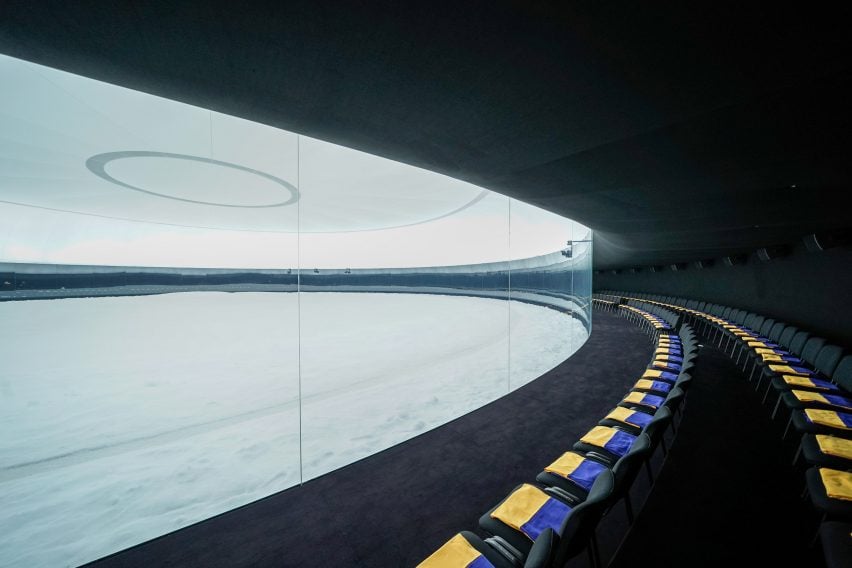
The set design for the show was created in reference to the ongoing climate crisis.
"In a not-so-distant future, what was once considered ubiquitous – banal, even – is now rarefied, often only experienceable via simulation," Balenciaga explained. "Weather, for example, is machine-made or rendered digitally; snow is exotic."
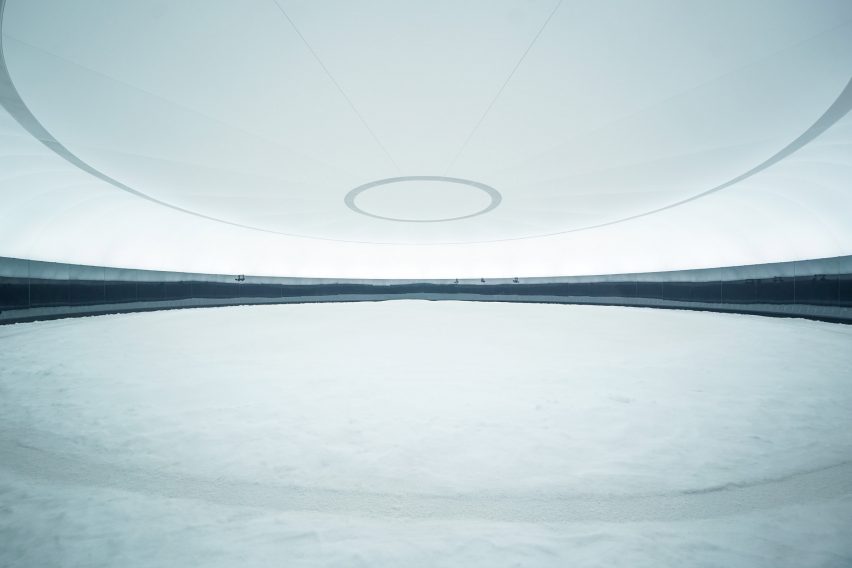
"The term 'winter' takes on a new meaning, although imbued with nostalgia for a time of predictable seasons," the brand added. "Just as a souvenir snow globe preserves a memory, the impending present plays out within a manufactured storm, mapping past winters onto the next."
The show space was shaped as a 360-degree rotunda bounded by a curving glass wall that separated its audience from a man-made snowstorm in a white field.
Set behind the glass wall, the audience was seated within a dark corridor lined with two rows of chairs that were oriented toward the snowy show space and laid with T-shirts in the colours of Ukraine's flag.
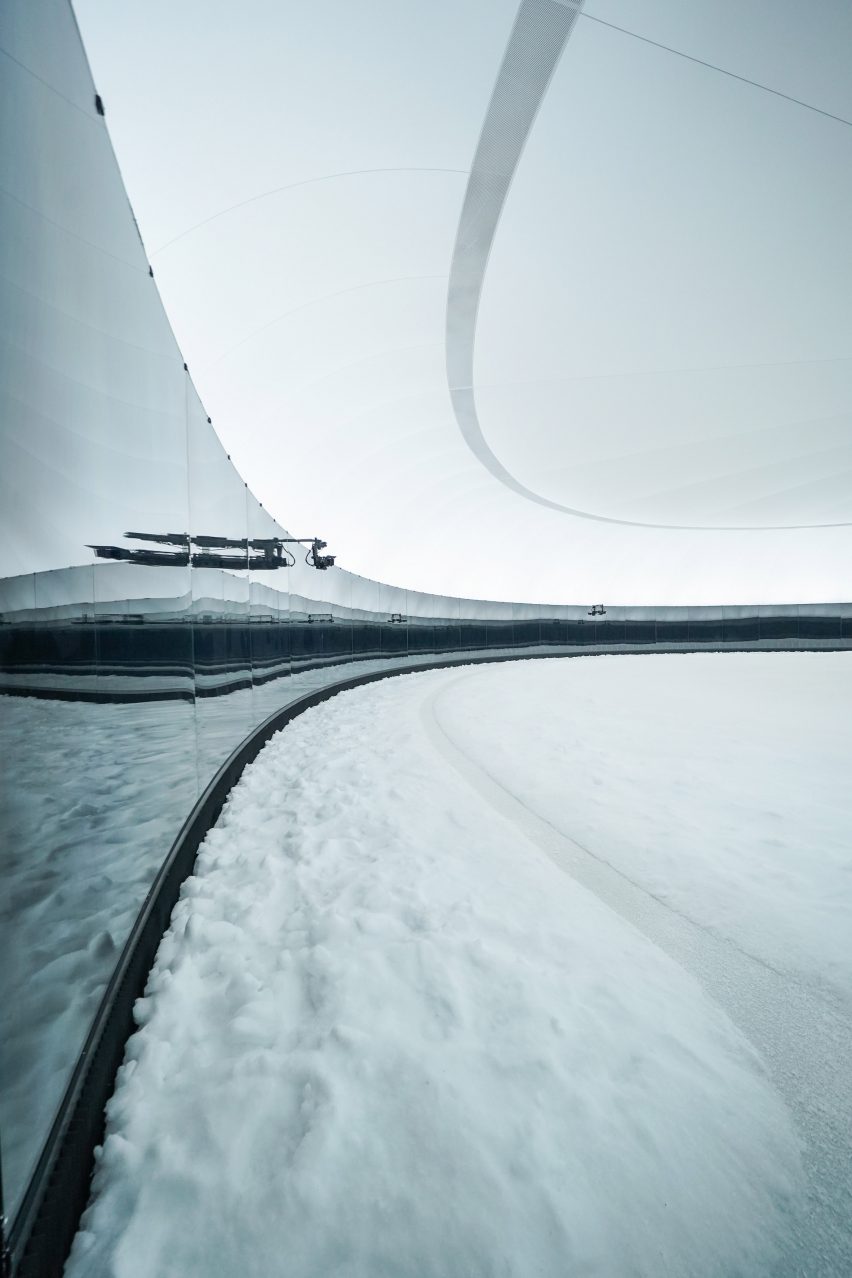
Bright white light, mimicking that of a snowy blizzard, was diffused throughout the rotunda and models were drawn from backstage by wind machines that billowed snow from the ground.
As models toiled through the arctic conditions, the "weather" conditions worsened as the show progressed, with light dimming and flickering to resemble that of a storm.
Models walked against the wind wrapped in towels that barely covered their undergarments, while others appeared holding onto the coloured ties of bags shaped like trash bags.
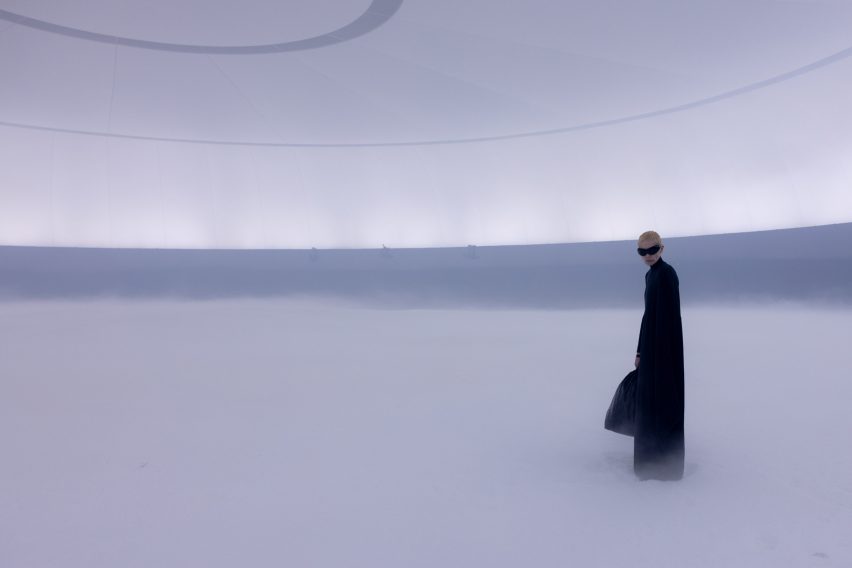
Balenciaga creative director Demna Gvasalia, who goes by Demna, dedicated the show to "resistance," as he said the Ukraine war had triggered past trauma.
"This show needs no explanation, it is a dedication to fearlessness, to resistance, and to the victory of love and peace," said Demna.
The show's theme of displacement was a personal message from the designer, who in 1993 was one of 250,000 Georgians forced from their homes during the Georgian civil war.
"The war in Ukraine has triggered the pain of a past trauma I have carried in me since 1993 when the same thing happened in my home country and I became a forever refugee," said Demna.
"Canceling the show would mean giving in, surrendering to the evil that has already hurt me so much for almost 30 years," he explained. "I decided that I can no longer sacrifice parts of me to that senseless, heartless war of ego."
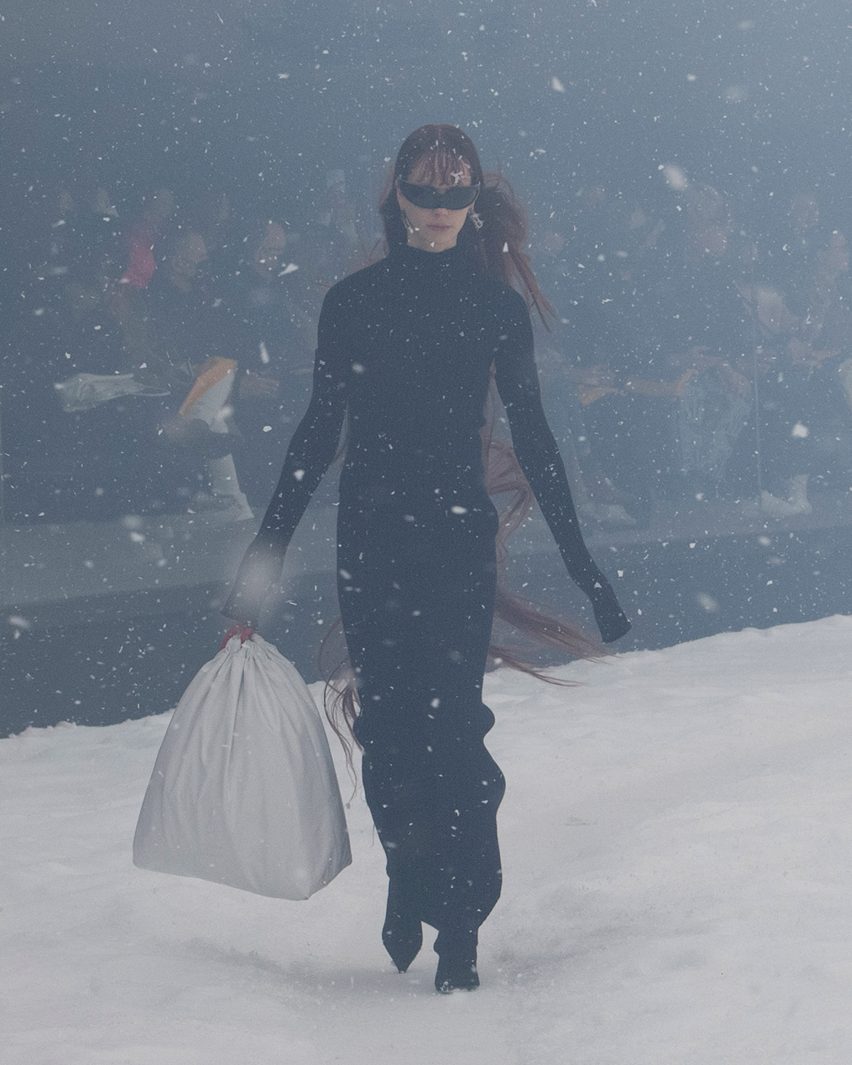
Among the pieces seen at the show were a floor-length leather coat crafted from a mycelium-derived leather alternative titled EPHEA, alongside oversized outerwear and tape-wrapped garments.
The penultimate and finale looks were designed in the brightly-hued colours of the Ukrainian flag: a yellow tracksuit and a blue dress in a stretch fabric with a lengthy train.

The show marked a return to the runway for Demna's ready-to-wear collections and picked up where Balenciaga's last physical show in March 2020 left off.
It was conceived as a part-two to the "biblical" Autumn/Winter 2020 show, where the audience was met with a sunken and flooded runway, an apocalyptic dress code and images of burning skies.

In the lead-up to the Autumn Winter 2022 show, Balenciaga wiped and paused its regular social media campaigns and dedicated the space to information and resources about the conflict in Ukraine.
The fashion house also donated to and partnered with The World Food Programme to provide assistance to those fleeing the conflict.
The war in Ukraine has seen a number of designers, architects and cultural institutions show solidarity with the country following Russia's invasion while an open letter condemning the invasion was signed by more than 6,500 Russian architects, designers and urban planners.
Photography is by Stéphane Aït Ouarab unless stated otherwise.
04-20-2022-0529 - Moon to Be Hit By 3 Ton Piece of Space Junk on Friday 03-03-2022
Moon to Be Hit By 3 Ton Piece of Space Junk on Friday
Read More: Moon to Be Hit By 3 Ton Piece of Space Junk on Friday | https://khak.com/moon-to-be-hit-by-3-ton-piece-of-space-junk-on-friday/?utm_source=tsmclip&utm_medium=referral
https://khak.com/moon-to-be-hit-by-3-ton-piece-of-space-junk-on-friday/
04-19-2022-2015 - Magnetic tension
Magnetic tension forces also rely on vector current densities and their interaction with the magnetic field. Plotting magnetic tension along adjacent field lines can give a picture as to their divergence and convergence with respect to each other as well as current densities.
Magnetic tension is analogous to the restoring force of rubber bands.
https://en.wikipedia.org/wiki/Magnetic_tension
04-19-2022-2001 - Convection
Convection (or convective heat transfer) is the transfer of heat from one place to another due to the movement of fluid. Although often discussed as a distinct method of heat transfer, convective heat transfer involves the combined processes of conduction (heat diffusion) and advection (heat transfer by bulk fluid flow). Convection is usually the dominant form of heat transfer in liquids and gases.
Note that this definition of convection is only applicable in Heat transfer and thermodynamic contexts. It should not to be confused with the dynamic fluid phenomenon of convection, which is typically referred to as Natural Convection in thermodynamic contexts in order to distinguish the two.
https://en.wikipedia.org/wiki/Convection_(heat_transfer)
In the field of physics, engineering, and earth sciences, advection is the transport of a substance or quantity by bulk motion of a fluid. The properties of that substance are carried with it. Generally the majority of the advected substance is a fluid. The properties that are carried with the advected substance are conserved properties such as energy. An example of advection is the transport of pollutants or silt in a river by bulk water flow downstream. Another commonly advected quantity is energy or enthalpy. Here the fluid may be any material that contains thermal energy, such as water or air. In general, any substance or conserved, extensive quantity can be advected by a fluid that can hold or contain the quantity or substance.
During advection, a fluid transports some conserved quantity or material via bulk motion. The fluid's motion is described mathematically as a vector field, and the transported material is described by a scalar field showing its distribution over space. Advection requires currents in the fluid, and so cannot happen in rigid solids. It does not include transport of substances by molecular diffusion.
Advection is sometimes confused with the more encompassing process of convection which is the combination of advective transport and diffusive transport.
In meteorology and physical oceanography, advection often refers to the transport of some property of the atmosphere or ocean, such as heat, humidity (see moisture) or salinity. Advection is important for the formation of orographic clouds and the precipitation of water from clouds, as part of the hydrological cycle.
https://en.wikipedia.org/wiki/Advection
Orography (from the Greek όρος, hill, γραφία, to write) is the study of the topographic relief of mountains,[1] and can more broadly include hills, and any part of a region's elevated terrain.[2] Orography (also known as oreography, orology or oreology) falls within the broader discipline of geomorphology.[3]
https://en.wikipedia.org/wiki/Orography
Salinity (/səˈlɪnɪti/) is the saltiness or amount of salt dissolved in a body of water, called saline water (see also soil salinity). It is usually measured in g/L or g/kg (grams of salt per liter/kilogram of water; the latter is dimensionless and equal to ‰).
Salinity is an important factor in determining many aspects of the chemistry of natural waters and of biological processes within it, and is a thermodynamic state variable that, along with temperature and pressure, governs physical characteristics like the density and heat capacity of the water.
A contour line of constant salinity is called an isohaline, or sometimes isohale.
https://en.wikipedia.org/wiki/Salinity
Membrane bioreactor (MBR) is a combination of membrane process like microfiltration or ultrafiltration with a biological wastewater treatment process, the activated sludge process. It is now widely used for municipal and industrial wastewater treatment.[1]
https://en.wikipedia.org/wiki/Membrane_bioreactor
Acid mine drainage, acid and metalliferous drainage (AMD), or acid rock drainage (ARD) is the outflow of acidic water from metal mines or coal mines.
https://en.wikipedia.org/wiki/Acid_mine_drainage
Anthracite, also known as hard coal, and black coal, is a hard, compact variety of coal that has a submetallic luster. It has the highest carbon content, the fewest impurities, and the highest energy density of all types of coal and is the highest ranking of coals.
Anthracite is the most metamorphosed type of coal (but still represents low-grade metamorphism),[a] in which the carbon content is between 86% and 97%.[1][3][4] The term is applied to those varieties of coal which do not give off tarry or other hydrocarbon vapours when heated below their point of ignition.[5] Anthracite ignites with difficulty and burns with a short, blue, and smokeless flame.
Anthracite is categorised into standard grade, which is used mainly in power generation,[contradictory] and high grade (HG) and ultra high grade (UHG), the principal uses of which are in the metallurgy sector. Anthracite accounts for about 1% of global coal reserves,[6] and is mined in only a few countries around the world.
The Coal Region of northeastern Pennsylvania in the United States is home to the largest known deposits of anthracite coal in the world with an estimated reserve of seven billion short tons.[7]China accounts for the majority of global production; other producers are Russia, Ukraine, North Korea, South Africa, Vietnam, the UK, Australia, Canada, and the United States. Total production in 2020 was 615 million tons.[8]
Trace metal and semi-metal contamination[edit]
Many acid rock discharges also contain elevated levels of potentially toxic metals, especially nickel and copper with lower levels of a range of trace and semi-metal ions such as lead, arsenic, aluminium, and manganese. The elevated levels of heavy metals can only be dissolved in waters that have a low pH, as is found in the acidic waters produced by pyrite oxidation. In the coal belt around the south Wales valleys in the UK highly acidic nickel-rich discharges from coal stocking sites have proved to be particularly troublesome.[citation needed]
https://en.wikipedia.org/wiki/Anthracite
https://en.wikipedia.org/wiki/Salinity
Jump to navigationJump to search
| Part of a series on |
| Continuum mechanics |
|---|
 |
show Laws |
show Scientists |
In continuum mechanics, vorticity is a pseudovector field that describes the local spinning motion of a continuum near some point (the tendency of something to rotate[1]), as would be seen by an observer located at that point and traveling along with the flow. It is an important quantity in the dynamical theory of fluids and provides a convenient framework for understanding a variety of complex flow phenomena, such as the formation and motion of vortex rings.[2][3]
Mathematically, the vorticity 

where 


In a two-dimensional flow, 
https://en.wikipedia.org/wiki/Vorticity
Wind shear (or windshear), sometimes referred to as wind gradient, is a difference in wind speed and/or direction over a relatively short distance in the atmosphere. Atmospheric wind shear is normally described as either vertical or horizontal wind shear. Vertical wind shear is a change in wind speed or direction with a change in altitude. Horizontal wind shear is a change in wind speed with a change in lateral position for a given altitude.[1]
Wind shear is a microscale meteorological phenomenon occurring over a very small distance, but it can be associated with mesoscale or synoptic scale weather features such as squall lines and cold fronts. It is commonly observed near microbursts and downbursts caused by thunderstorms, fronts, areas of locally higher low-level winds referred to as low-level jets, near mountains, radiation inversions that occur due to clear skies and calm winds, buildings, wind turbines, and sailboats. Wind shear has significant effects on the control of an aircraft, and it has been the sole or a contributing cause of many aircraft accidents.
Sound movement through the atmosphere is affected by wind shear, which can bend the wave front, causing sounds to be heard where they normally would not, or vice versa. Strong vertical wind shear within the troposphere also inhibits tropical cyclone development but helps to organize individual thunderstorms into longer life cycles which can then produce severe weather. The thermal wind concept explains how differences in wind speed at different heights are dependent on horizontal temperature differences and explains the existence of the jet stream.[2]
https://en.wikipedia.org/wiki/Wind_shear
In meteorology, convective available potential energy (commonly abbreviated as CAPE),[1] is the integrated amount of work that the upward (positive) buoyancy force would perform on a given mass of air (called an air parcel) if it rose vertically through the entire atmosphere. Positive CAPE will cause the air parcel to rise, while negative CAPE will cause the air parcel to sink. Nonzero CAPE is an indicator of atmospheric instability in any given atmospheric sounding, a necessary condition for the development of cumulus and cumulonimbus clouds with attendant severe weather hazards.
https://en.wikipedia.org/wiki/Convective_available_potential_energy
In fluid dynamics, a barotropic fluid is a fluid whose density is a function of pressure only.[1] The barotropic fluid is a useful model of fluid behavior in a wide variety of scientific fields, from meteorology to astrophysics.
The density of most liquids is nearly constant (isopycnic), so it can be stated that their densities vary only weakly with pressure and temperature. Water, which varies only a few percent with temperature and salinity, may be approximated as barotropic. In general, air is not barotropic, as it is a function of temperature and pressure; but, under certain circumstances, the barotropic assumption can be useful.
In astrophysics, barotropic fluids are important in the study of stellar interiors or of the interstellar medium. One common class of barotropic model used in astrophysics is a polytropic fluid. Typically, the barotropic assumption is not very realistic.
In meteorology, a barotropic atmosphere is one that for which the density of the air depends only on pressure, as a result isobaric surfaces (constant-pressure surfaces) are also constant-density surfaces. Such isobaric surfaces will also be isothermal surfaces, hence (from the thermal wind equation) the geostrophic wind will not vary with depth. Hence, the motions of a rotating barotropic air mass is strongly constrained. The tropics are more nearly barotropic than mid-latitudes because temperature is more nearly horizontally uniform in the tropics.
A barotropic flow is a generalization of a barotropic atmosphere. It is a flow in which the pressure is a function of the density only and vice versa. In other words, it is a flow in which isobaric surfaces are isopycnic surfaces and vice versa. One may have a barotropic flow of a non-barotropic fluid, but a barotropic fluid will always follow a barotropic flow. Examples include barotropic layers of the oceans, an isothermal ideal gas or an isentropic ideal gas.
A fluid which is not barotropic is baroclinic, i. e., pressure is not the only factor to determine density. For a barotropic fluid or a barotropic flow (such as a barotropic atmosphere), the baroclinic vector is zero.
https://en.wikipedia.org/wiki/Barotropic_fluid
An isopycnic surface is a surface of constant density inside a fluid. Isopycnic surfaces contrast with isobaric or isothermal surfaces, which describe surfaces of constant pressure and constant temperature respectively. Isopycnic surfaces are sometimes referred to as "iso-density" surfaces, although this is strictly incorrect. Isopycnic typically describes surfaces, not processes. Unless there is a flux of mass into or out of a control volume, a process which occurs at a constant density also occurs at a constant volume and is called an isochoric process and not an isopycnic process.
https://en.wikipedia.org/wiki/Isopycnic
In atmospheric thermodynamics, the virtual temperature (
Description[edit]
In atmospheric thermodynamic processes, it is often useful to assume air parcels behave approximately adiabatically, and approximately ideally. The specific gas constant for the standardized mass of one kilogram of a particular gas is variable, and described mathematically as
where 


with 




https://en.wikipedia.org/wiki/Virtual_temperature
In physics, magnetic tension is a restoring force with units of force density that acts to straighten bent magnetic field lines. The force density (in SI) 


where 
Magnetic tension forces also rely on vector current densities and their interaction with the magnetic field. Plotting magnetic tension along adjacent field lines can give a picture as to their divergence and convergence with respect to each other as well as current densities.
Magnetic tension is analogous to the restoring force of rubber bands.
https://en.wikipedia.org/wiki/Magnetic_tension
A magnetic field is a vector field that describes the magnetic influence on moving electric charges, electric currents,[1]: ch1 [2] and magnetic materials. A moving charge in a magnetic field experiences a force perpendicular to its own velocity and to the magnetic field.[1]: ch13 [3] A permanent magnet's magnetic field pulls on ferromagnetic materials such as iron, and attracts or repels other magnets. In addition, a magnetic field that varies with location will exert a force on a range of non-magnetic materials by affecting the motion of their outer atomic electrons. Magnetic fields surround magnetized materials, and are created by electric currents such as those used in electromagnets, and by electric fields varying in time. Since both strength and direction of a magnetic field may vary with location, it is described mathematically by a function assigning a vector to each point of space, called a vector field.
In electromagnetics, the term "magnetic field" is used for two distinct but closely related vector fields denoted by the symbols B and H. In the International System of Units, H, magnetic field strength, is measured in the SI base units of ampere per meter (A/m).[4] B, magnetic flux density, is measured in tesla (in SI base units: kilogram per second2 per ampere),[5] which is equivalent to newton per meter per ampere. H and B differ in how they account for magnetization. In a vacuum, the two fields are related through the vacuum permeability, 
Magnetic fields are produced by moving electric charges and the intrinsic magnetic moments of elementary particles associated with a fundamental quantum property, their spin.[6][1]: ch1 Magnetic fields and electric fields are interrelated and are both components of the electromagnetic force, one of the four fundamental forces of nature.
Magnetic fields are used throughout modern technology, particularly in electrical engineering and electromechanics. Rotating magnetic fields are used in both electric motors and generators. The interaction of magnetic fields in electric devices such as transformers is conceptualized and investigated as magnetic circuits. Magnetic forces give information about the charge carriers in a material through the Hall effect. The Earth produces its own magnetic field, which shields the Earth's ozone layer from the solar wind and is important in navigation using a compass.
https://en.wikipedia.org/wiki/Magnetic_field#Magnetic_field_lines



